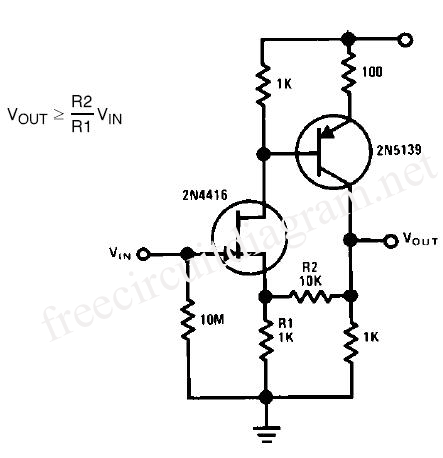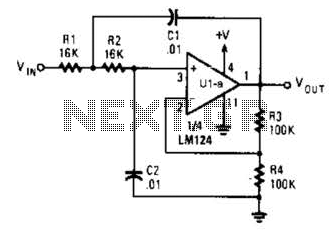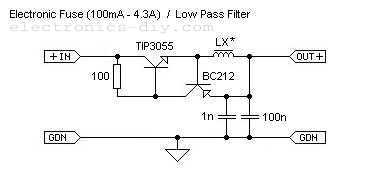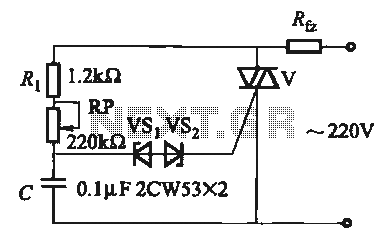
The same capacitance parameters 12dB-oct low-pass filter

In this circuit, A = 1, port = 0.5, and it features a passive vent filter without distinction. Attention is required when the circuit is dry; Q is determined by the formula Q = 1 / (3 - A). It utilizes a Butterworth filter with a slope of 12 dB/octave, where F0.707 and a mouth may be assumed. Further details include: a = 3 ^ ci / o) = 1.585, with R4 equal to Rs (A-1). When R3 is set to 10 kΩ, the desired roar is 5.8 kΩ, with a series resistance of 5.1 kΩ and a total of 7.5 kΩ. This configuration allows for a passband gain of 4-1.585, which is then connected to the front stage or satin circuit that attenuates the feedback capacitor of 111.585. The role of the 0 mM capacitor is to inhibit input capacitance spikes of the operational amplifier. Although the cut-off frequency fL can be adjusted, when fL is set to 100 kHz and if the set value is 10 kΩ, then Co is 160 pF. The input capacitance of the operational amplifier or parasitic capacitance will have an impact, requiring G. From must reduce to 5-10 pF calculated values. Additionally, the gain of the operational amplifier can be substituted with a single wideband product.
This circuit design employs a passive vent filter configuration aimed at achieving specific frequency response characteristics. The Butterworth filter design is notable for its maximally flat frequency response, which is critical for applications requiring minimal phase distortion. The parameters defined in the circuit, such as A, port, and Q, are essential for determining the overall behavior of the filter. The relationship between R3 and the desired roar resistance is crucial for tuning the circuit to achieve optimal performance.
The choice of a Butterworth filter with a -12 dB/octave slope indicates a preference for a smooth roll-off, which is beneficial in applications where signal integrity is paramount. The operational amplifier's feedback capacitor plays a significant role in stabilizing the circuit and preventing unwanted oscillations. The specified cut-off frequency (fL) of 100 kHz is a critical design choice, as it defines the bandwidth of the filter. The adjustment of the input capacitance and parasitic capacitance is necessary to maintain the desired performance, particularly in high-frequency applications where such factors can significantly influence the circuit's behavior.
In summary, this circuit is designed to provide a stable and predictable frequency response, utilizing careful component selection and configuration to achieve the desired electrical characteristics while minimizing potential issues related to capacitance and feedback.In this circuit, A = 1, port = o.5, passive vent filter without distinction. When only care when dry l; Q = 1 / (3 - A), 12dB / oct filter of Butterworth King F0.707,4 mouth may be assumed as follows: a = 3 ^ ci / o) = 1.s8s, according to R4 = Rs (A-1), when R3 = iok0, the roar desirable 5.8sko, with s.iko and series from 7500. In this way may have a 4-1. 585 passband gain, and then connected to the front stage or satin circuit attenuates the feedback capacitor 111.
585. 0 mM role is to inhibit the OP amplifier input capacitance due to cl produced spikes. Although the cut-off frequency fL is set a certain degree of freedom, but when fL = Loo kHz, if the set. = iok Q, then Co F160pF, OP amplifier input capacitance 0- or parasitic capacitance will have an impact, so G.
From must reduce 5 ~ lOpF calculated values. In addition, OP amplifier gain can be replaced by a single wide band products.
This circuit design employs a passive vent filter configuration aimed at achieving specific frequency response characteristics. The Butterworth filter design is notable for its maximally flat frequency response, which is critical for applications requiring minimal phase distortion. The parameters defined in the circuit, such as A, port, and Q, are essential for determining the overall behavior of the filter. The relationship between R3 and the desired roar resistance is crucial for tuning the circuit to achieve optimal performance.
The choice of a Butterworth filter with a -12 dB/octave slope indicates a preference for a smooth roll-off, which is beneficial in applications where signal integrity is paramount. The operational amplifier's feedback capacitor plays a significant role in stabilizing the circuit and preventing unwanted oscillations. The specified cut-off frequency (fL) of 100 kHz is a critical design choice, as it defines the bandwidth of the filter. The adjustment of the input capacitance and parasitic capacitance is necessary to maintain the desired performance, particularly in high-frequency applications where such factors can significantly influence the circuit's behavior.
In summary, this circuit is designed to provide a stable and predictable frequency response, utilizing careful component selection and configuration to achieve the desired electrical characteristics while minimizing potential issues related to capacitance and feedback.In this circuit, A = 1, port = o.5, passive vent filter without distinction. When only care when dry l; Q = 1 / (3 - A), 12dB / oct filter of Butterworth King F0.707,4 mouth may be assumed as follows: a = 3 ^ ci / o) = 1.s8s, according to R4 = Rs (A-1), when R3 = iok0, the roar desirable 5.8sko, with s.iko and series from 7500. In this way may have a 4-1. 585 passband gain, and then connected to the front stage or satin circuit attenuates the feedback capacitor 111.
585. 0 mM role is to inhibit the OP amplifier input capacitance due to cl produced spikes. Although the cut-off frequency fL is set a certain degree of freedom, but when fL = Loo kHz, if the set. = iok Q, then Co F160pF, OP amplifier input capacitance 0- or parasitic capacitance will have an impact, so G.
From must reduce 5 ~ lOpF calculated values. In addition, OP amplifier gain can be replaced by a single wide band products.
Warning: include(partials/cookie-banner.php): Failed to open stream: Permission denied in /var/www/html/nextgr/view-circuit.php on line 713
Warning: include(): Failed opening 'partials/cookie-banner.php' for inclusion (include_path='.:/usr/share/php') in /var/www/html/nextgr/view-circuit.php on line 713





